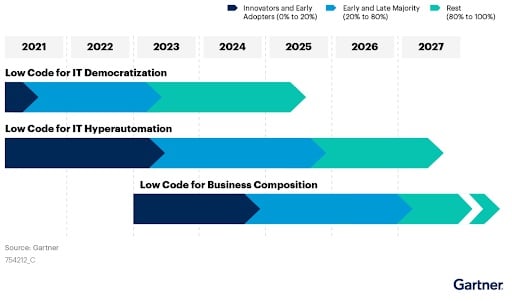
Where is low-code heading? And how should you use it in your business?
A recent Gartner report* sheds some much-needed light on the future of low code. According to Gartner®, “Low code has emerged in the last five years as one potential tool in both enabling business transformation and scaling these initiatives cost-effectively over time.”
But is it right for your business right now? Read on to find out.
In a nutshell
- More people outside IT are using low-code (LC). And they’re building useful business tools. According to Gartner, “By 2024, developers outside formal IT departments will account for at least 80% of the user base for LC technology/tools, up from 60% in 2021.”
- The low-code world is still fuzzy. There are many levels of automation and application capabilities. That can make it tough to identify specific markets and developer profiles.
- Low code is going to spread fast in the next 5 years. We’ll see even more people outside IT using it. We’ll see it used in more business and IT processes. And we’ll see that it plays a part in making businesses more resilient.
According to Gartner, “Looking toward 2027, LC-enabled markets will evolve through three distinct phases: democratization, hyper-automation, and composable business. Each of these phases will be defined by distinctive influences across technology, market, and product/service characteristics.”
The question isn’t whether low-code will be around. It’s what form it will take. Gartner states, "By 2024, hyper-automation functionality will be the dominant competitive differentiator among LC development tools.”
3 Gartner-based recommendations to product leaders investing in LC technologies
- “Embrace technology democratization among prospective LC customers by focusing on specialized opportunities within technology-empowered business units over “one size fits all” enterprisewide engagements.”
- “Promote developer experience product investments that drive opportunities for the abstraction of complexity for business processes to support both less sophisticated users and future-state acceleration of decision automation.”
- “Leverage the LC market evolution spectrum and opportunities to address competing priorities and market ambiguity by navigating critical conversations as product leaders through structured planning to determine key roadmap and go-to-market investments.”
Low code evolution spectrum

According to Gartner, “looking toward 2027, LC markets will evolve through three distinct phases, including low code for IT democratization, low code for hyper-automation, and low code for business composition. Each of these phases will be defined by distinctive influences across technology, market, and, product/service characteristics.”
Tell me more about low-code for IT democratization -
Phase 1
According to Gartner, “This phase of low code focuses on continuing the trends in rapid application development (RAD) tooling/techniques that have been around for decades.”
The most successful implementations are cloud-based. Gartner notes “Typical LC solutions in this phase focus on small to moderately complex projects, with a targeted life cycle of three to five years deployed by small teams of two to four developers. However, a small subset of the market also supports larger and more complex projects. Signature characteristics include ease of use and “light touch” IT moderation to give LC developers freedom and flexibility while avoiding the downside of shadow IT.”
Low code is the next generation of rapid application development. Gartner notes “These LC “developers” typically focus on small projects — one to three developers building applications with one- to three-year life cycles”. According to us, LC enables much quicker development cycles than traditional development.
During this phase, product leaders can continue simplifying the developer experience and making the value of low code clear to end users.
Tell me more about low-code for IT hyper-automation - Phase 2
Hyperautomation makes it even easier and faster to automate business and IT processes.
According to Gartner, “Toward this end, LC-enabled technology becomes a key success factor in making hyper-automation strategies achievable among a wide spectrum of organizations.”
“This phase of low code is enabled in large part by machine learning and AI techniques to transform how software logic is developed, managed, consumed, and shared.... The scope of automation supported by LC tools and technology falls into three levels: Task-level automation, Process-level automation, and Process orchestration.”
During this phase, low-code teams grow into what Gartner calls fusion teams. Gartner states that these are, “multidisciplinary teams that blend technology or analytics and business domain expertise, and share accountability for business and technology outcomes.”
From the Gartner report, we understand that it’s likely that low-code will become more integrated with DevOps; reporting and monitoring will also become more sophisticated. The ease of use and simplicity of low code will continue to be focal points.
Tell me more about low-code for business composition - Phase 3
Gartner states: “This phase of low code extends the core functionality of the previous two phases by focusing on support of the “composable enterprise”.... Its purpose is to enable agility and resilience in the face of unexpected and unprecedented events.”
It is our understanding that Low-code can do this by being the mechanism for assembling Packaged Business Capabilities (PBCs). These are components that allow business leaders to implement what Gartner calls “composable business strategies”.
During this phase, IT involvement will once again increase. According to Gartner, “Fusion teams will work closely with IT (and external-sourced PBCs) to support the full life cycle of next-generation composable solutions.”
According to us, the report summarizes that the low-code themes of simplicity, agility, and ease of use will continue to be central.
Conclusion
We believe that low code is not only on the map - its territory is growing. And it will allow more and more people outside IT to build apps and tools that automate business processes.
The strong points of low code include ease of use and speed of implementation. These will remain strengths as low code evolves.
Businesses that make low-code part of their DNA will be able to reap the benefits of both hyper-automation and Packaged Business Capabilities (PBCs). These will be advantages in quickly changing and unpredictable markets.
===
GARTNER is the registered trademark and service mark of Gartner Inc., and/or its affiliates and has been used herein with permission. All rights reserved.
